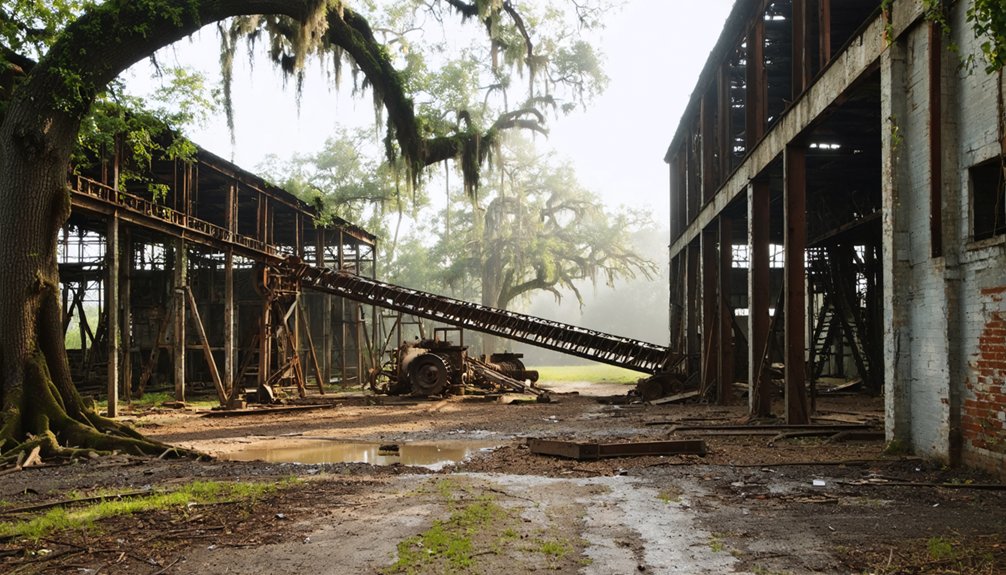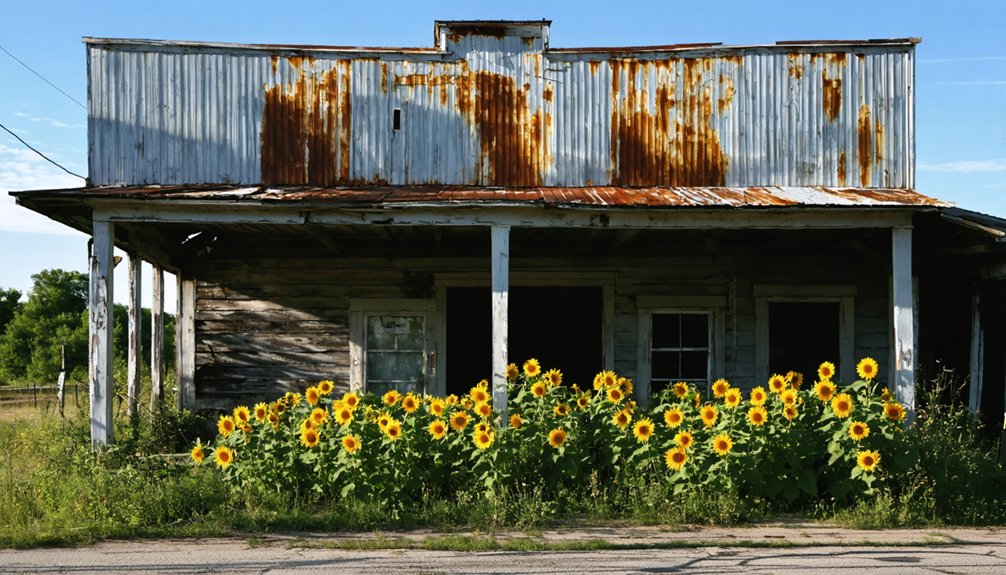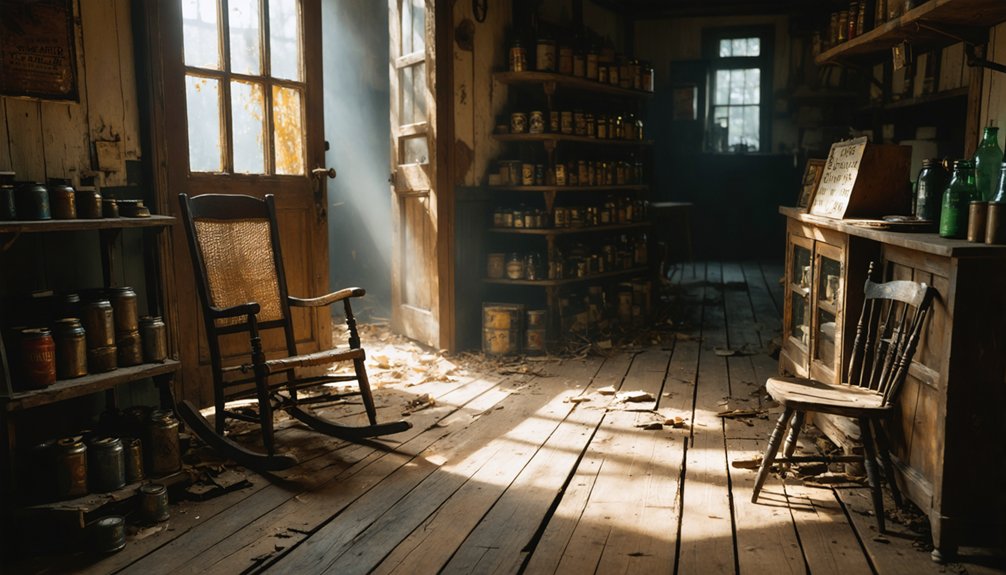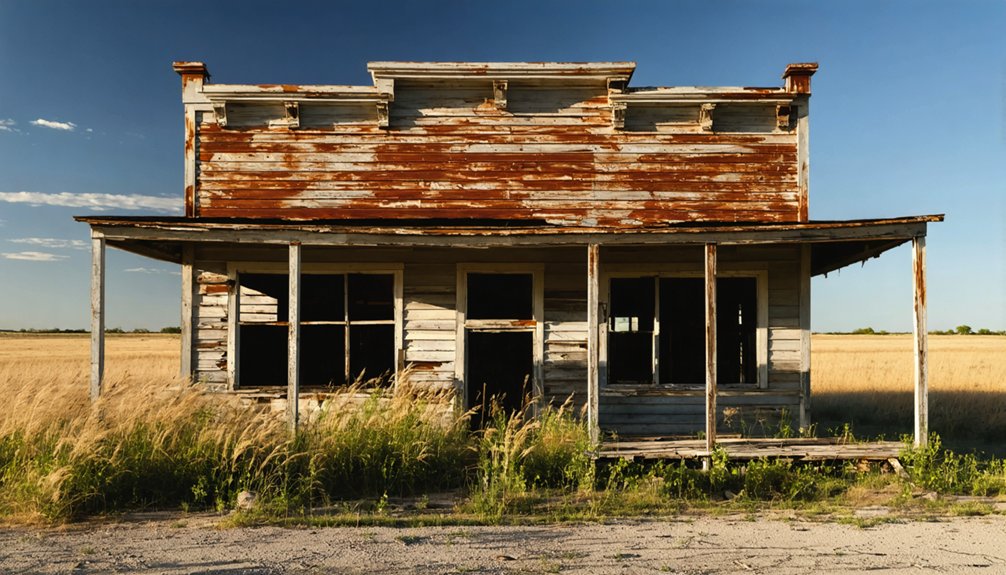You’ll find the ghost town of Fuqua 10 miles north of Woodville in Tyler County, Texas. This former lumber boomtown flourished under Kirby Lumber Company’s ownership in the early 1900s, boasting a population of 1,000 residents, 225 worker houses, and a sawmill that produced 25 million board feet annually. Today, only grass-covered clearings and hidden foundations mark where this once-bustling company town stood. The site’s weathered remnants tell a deeper story of East Texas’s industrial past.
Key Takeaways
- Fuqua, Texas transformed from a thriving lumber town of 1,000 residents into a ghost town after Kirby Lumber Company’s mill declined and closed.
- The town originated as Fuqua’s Prairie in 1832, later becoming a major lumber production center with Kirby Lumber Company in 1901.
- Infrastructure included 225 tenant houses, a commissary, railway depot, and eight miles of tramlines serving the lumber operations.
- The community featured Methodist and Baptist churches, a company store, cotton gins, and a medical dispensary for workers.
- Today, only grass-covered clearings, weathered foundations, and scattered industrial artifacts remain of the once-bustling lumber town.
The Rise of a Lumber Empire
The thunderous arrival of the Kirby Lumber Company in 1901 transformed the quiet settlement of Fuqua into a bustling center of lumber production. With $10 million in capital and the distinction of being America’s largest lumber company, Kirby’s presence signaled a new era of industrial might in East Texas.
You’d have witnessed D.C. Hackney‘s swift construction of the original mill in 1901, followed by Kirby’s acquisition in January 1902. The company’s approach to industrial consolidation was direct – they bought mills outright, including Fuqua’s, rather than just merging management. Workers endured eleven-hour workdays until 1900, pushing through exhausting shifts to meet production demands. Under the guidance of T.M. Caselbery’s expertise, the logging operations maintained a steady supply of timber to feed the mill’s growing appetite.
The mill’s evolution was remarkable, upgrading from a simple circular saw to advanced equipment like the 8-foot Allis band saw. By 1904, you could’ve seen the mill churning out 100,000 board feet daily, cementing Fuqua’s role in Texas’s lumber empire.
Life in Early Fuqua Settlement
You’d find the early Fuqua settlement dominated by rows of 225 tenant houses where sawmill workers paid $1.50 monthly for family healthcare while living under the company-town system.
The Fuqua family legacy began when Ephraim Fuqua first settled the land in the 1830s after receiving a Republic of Texas land grant.
Your social life would center around the community house, where organizations like the Woodmen of the World, Masons, and Pythians gathered regularly for fraternal activities.
Between shifts at the mill, you might visit Will Fuqua’s general store or the company commissary, where mill checks served as the primary currency for daily necessities.
Cotton was a major part of local industry, as the Fuqua brothers’ gins processed the area’s harvests throughout the 1890s.
Daily Mill Worker Routines
Life at Fuqua’s bustling sawmill began well before dawn, as workers streamed into the facility for grueling 10-12 hour shifts that defined the town’s industrial rhythm. Like the coal miners of Thurber, laborers received their wages through a restrictive once-a-month paycheck system. The workforce consisted of 100 to 125 dedicated mill hands and loggers keeping the massive operation running.
You’d find yourself caught in the daily mill routines of operating heavy band saws, hauling timber, and maintaining essential machinery. Worker health depended on the company dispensary, where your monthly $1.50 healthcare deduction guaranteed treatment for common sawmill injuries.
- Sawdust-filled air mingles with morning fog as you load logs from railcars
- Your calloused hands grip worn tools while manning the thundering band saws
- Steam whistles pierce the air, signaling brief respites at the bustling commissary
- Mill checks jingle in your pocket, ready for exchange at the company store
- Your boots crunch across sawdust-covered paths between towering lumber stacks
Early Housing and Infrastructure
While sawmill operations drove Fuqua’s rapid growth, a bustling community of 300 mill hands and loggers made their homes in roughly 225 company-owned tenant houses by 1910.
You’d find a well-organized settlement where tenant housing fostered community cohesion, with families living close to the mill site and essential services.
The town’s infrastructure included everything you’d need: a commissary where workers spent their mill checks, a depot for railway connections, and a community house where the Masons and Woodmen of the World gathered.
Eight miles of tramlines connected the 100,000-board-feet-capacity mill to timber sources, while the Gulf, Colorado and Santa Fe Railway linked Fuqua to regional markets.
A dispensary provided healthcare for $1.50 monthly per family, ensuring workers’ well-being and productivity. Similar to the Roman dux commanders who governed provinces, the mill owners exercised complete authority over the company town’s operations and infrastructure.
The Kirby Lumber Company established its presence in Fuqua with advanced facilities including a kiln, planer, and sawmill.
Community Social Activities
The social fabric of early Fuqua was woven through its religious institutions, with Methodist and Baptist congregations serving as the community’s spiritual anchors.
You’d find robust community bonding at Steele’s Chapel Methodist and Fuqua Prairie Baptist Church, where social gatherings extended beyond Sunday services. Like many American family surname communities, Fuqua’s residents maintained strong ties to their ancestral traditions through these religious gatherings.
The community house hosted fraternal organizations like the Woodmen of the World and Masons, while Stegall’s commissary served as a bustling social hub where mill workers gathered.
- Circuit riders on horseback bringing spiritual guidance to scattered homesteads
- Church bells ringing across Fuqua Prairie, calling folks to worship
- Workers gathering at the commissary’s wooden porch, sharing stories after shifts
- Ladies organizing potluck dinners at the community house
- Children playing near the Green Valley Church while families socialized after services
The Golden Age of Timber Production
During Fuqua’s peak years of timber production, Kirby Lumber Company transformed a modest sawmill into an industrial powerhouse after purchasing it from D.C. Hackney in 1901.
You’d find impressive timber innovations throughout the operation, including an 8-foot Allis band saw and a Giddings & Lewis steam gang saw that could cut up to 90,000 board feet in a 10-hour shift.
At its height in 1905, the mill’s annual capacity reached 25 million board feet, supported by two locomotives and 35 log cars moving timber from Fuqua’s 10,000 acres of virgin longleaf pine. The operation was part of Texas’s lumber production boom that flourished after railroads expanded across the state in the 1880s.
Despite challenges with resource management in the flood-prone Trinity River plains, the operation employed over 100 workers and maintained substantial log reserves to keep the mill running during wet conditions.
Daily Operations at Kirby Lumber Mill

Powering through massive logs daily, Kirby Lumber Company‘s upgraded Fuqua mill operated with impressive precision and scale.
The Fuqua mill’s advanced machinery carved through timber with relentless efficiency, setting new standards for industrial lumber production.
You’d witness the 8-foot Allis band saw and Giddings & Lewis steam gang saw slice through pine timber, while the mill upgrades allowed production of up to 100,000 board feet per day.
The logging techniques employed by T. M. Caselbery’s crew kept the operation humming with a steady supply from the surrounding forests.
- Two mighty steam engines – 300hp and 150hp – driving the sawmill and planing mill respectively
- Six molders and matchers shaping lumber with mechanical precision
- Locomotives hauling fresh-cut logs along eight miles of tramlines
- Steam kilns drying 50,000 board feet of lumber daily
- Over 100 loggers working the timber camps, keeping the mill supplied year-round
The Slow Decline of a Bustling Town
While Kirby Lumber’s Fuqua mill once buzzed with productive energy, signs of decline emerged as early as 1905 when annual lumber capacity dropped from 25 million to 16 million feet.
By 1918, you’d have witnessed production plummet further to 12 million feet, creating a devastating economic impact on the town’s liveliness.
Despite the community’s resilience, Fuqua couldn’t sustain its peak population of 1,000 residents as the mill’s struggles intensified.
The town’s fabric began unraveling as Kirby relocated machinery to Honey Island, and essential services vanished one by one.
You’d have seen the commissary, dispensary, and community house – once vibrant social hubs – gradually empty out.
What Remains Today

When you explore Fuqua’s abandoned landscape today, you’ll find scattered remnants of the old mill site tucked away in grass-covered clearings that were once bustling with activity.
Hidden forest areas have gradually encroached upon what used to be open town spaces, though you can still spot weathered foundations and structural footings amid the wild vegetation.
The old railroad trail‘s subtle traces weave through the property, marked by occasional bits of timber and faint depressions in the earth where tracks once lay.
Mill Site Remnants
The decaying remnants of Fuqua’s once-bustling lumber mill paint a ghostly portrait of East Texas’s industrial past.
You’ll find concrete and brick mill foundation remnants scattered among nature’s reclamation, with industrial artifact preservation happening naturally beneath layers of soil and vegetation.
Over eight miles of former tramlines weave through the woods, marked by subtle earthen embankments and rusted rails that once transported lumber through the East Texas wilderness.
- Weathered iron fittings and machinery parts protrude from the forest floor
- Crumbling concrete foundations peek through thick underbrush
- Old steam engine fragments surface after heavy rains
- Wooden tramline ties decay quietly along forgotten rail paths
- Rusted gears and chains rest among fallen leaves, telling tales of industrial might
Hidden Forest Clearings
Deep within Liberty County‘s thick East Texas woods, hidden forest clearings mark where Fuqua’s bustling town once stood. You’ll find these hidden ecosystems scattered near County Road 2650, where nature steadily reclaims what industry abandoned.
At 115 feet elevation, forgotten pathways of old tramlines crisscross the clearings, while scattered nails and metal fittings peek through decades of fallen pine needles.
As you explore these spaces, you’ll notice how pioneer species and native shrubs have transformed former industrial grounds. The clearings now support diverse wildlife, from deer to songbirds, amid regenerating loblolly pines and hardwoods.
Ground depressions hint at long-gone buildings, but the forest’s resurgence tells a new story of freedom and wilderness triumphing over the old mill town’s remains.
Railroad Trail Traces
Faint scars of Fuqua’s once-bustling railway network remain etched into Liberty County’s landscape, with over eight miles of former tramlines leaving subtle impressions through the woods near County Road 2650.
You’ll find these remnants of railroad history scattered throughout the area, though they’re barely visible to untrained eyes. The tramline routes that once transported millions of board feet of lumber now exist only as rough clearings and uneven ground.
- Deep-cut paths where steam locomotives once hauled massive logs
- Scattered depressions marking old railroad ties and bedding
- Weathered clearings that slice through dense forest growth
- Ghost corridors where log cars rolled day and night
- Hidden foundation traces of the original rail yard
If you’re exploring today, you’ll need a historian’s eye to spot these vanishing signs of Fuqua’s industrial past.
Historical Legacy in East Texas

Fuqua’s historical imprint on East Texas exemplifies the region’s early 20th-century lumber boom and subsequent decline.
You’ll find traces of community resilience in its origins as Fuqua’s Prairie, where the Ephraim Fuqua family established cotton farms and cattle operations in 1832. The town underwent dramatic economic transformation when the Kirby Lumber Company arrived, reaching peak production of sixteen million board feet by 1907.
While the lumber industry’s collapse led to Fuqua’s abandonment by the late 1920s, the town’s legacy lives on through its cemetery and the stories of multiple churches that once served the area, including Steele’s Chapel and the Green Valley Church.
Today, you can explore the remnants of this once-thriving community that symbolizes East Texas’s rich industrial heritage.
Frequently Asked Questions
Are There Any Known Cemetery Sites or Burial Grounds in Fuqua?
Like footprints in time, historic burials rest at the Fuqua Family Cemetery (also called Erwin Cemetery) at 5504 Erwin Cemetery Road. You’ll find cemetery legends spanning back to 1830s wagon trains.
What Wildlife Species Currently Inhabit the Abandoned Fuqua Town Site?
You’ll find diverse wildlife including raccoons, opossums, coyotes, white-tailed deer, various songbirds, raptors, snakes, and numerous invertebrates thriving among the ruins during wildlife observation sessions.
Has Anyone Reported Paranormal Activity or Ghost Sightings in Fuqua?
You’ll find documented ghostly encounters at the Fuqua Mansion, including phantom figures in windows, strange sounds, and a legendary ghost pit bull. Local legends also mention supernatural activity tied to the property’s murder history.
Were There Any Major Accidents or Disasters at the Fuqua Mill?
Through timber and time, through steam and steel, you won’t find major accidents or disasters documented at Fuqua Mill. Historical records show no significant incidents during its early 1900s operations.
Can Visitors Legally Explore the Fuqua Ghost Town Site Today?
You can’t legally explore without permission since it’s on private property. You’ll need to contact local landowners and obtain explicit approval before accessing any part of the site.
References
- http://swamplot.com/the-spooky-history-of-the-minnetex-mansion-kids-on-twitter-are-gearing-up-to-haunt-tonight/2014-10-31/
- https://en.wikipedia.org/wiki/Fuqua
- https://www.youtube.com/watch?v=phjUE19A8HM
- https://www.texasalmanac.com/places/fuqua
- https://www.tshaonline.org/handbook/entries/fuqua-tx
- https://en.wikipedia.org/wiki/List_of_ghost_towns_in_Texas
- http://www.wtblock.com/MillTownsGhostTowns.htm
- https://www.tshaonline.org/handbook/entries/lumber-industry
- https://ttarchive.com/Library/Articles/Kirby-Lbr-Fuqua_1902_Timber-Resources-of-East-Texas.html
- https://ttarchive.com/Library/Articles/Kirby-Lbr-Co_1902_Timber-Resources-of-East-Texas.html



